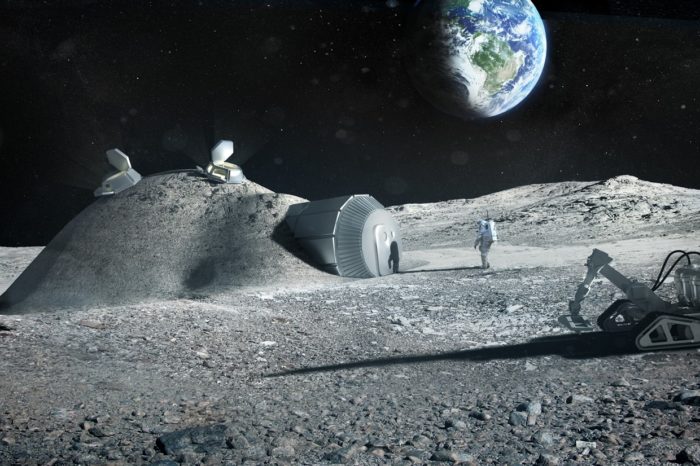Feb 21 2019
Making Water on the Moon
 If all goes well, the 2020s may be the decade that we return to the Moon. There is certainly renewed interest in the Moon, and we may, in fact, be entering a new space race with China.
If all goes well, the 2020s may be the decade that we return to the Moon. There is certainly renewed interest in the Moon, and we may, in fact, be entering a new space race with China.
In December 2018 NASA announced their updated Gateway mission plans – they seek to put a platform in permanent orbit around the moon, and then use the platform to shuttle astronauts to and from the Moon’s surface. They also hope to do all this within 10 years.
They will do this with the new Space Launch System (SLS) and the Orion capsule. This is a powerful rocket capable of deep space missions (beyond low-earth orbit). They also plan to partner with private industry for many of the components. NASA administrator, Jim Bridenstine, recently said:
“It’s important that we get back to the moon as fast as possible,” said Bridenstine in a meeting at NASA’s Washington headquarters, adding he hoped to have astronauts back there by 2028.
“This time, when we go to the Moon, we’re actually going to stay. We’re not going to leave flags and footprints and then come home to not go back for another 50 years” he said.
“We’re doing it entirely different than every other country in the world. What we’re doing is, we’re making it sustainable so you can go back and forth regularly with humans.”
I think this is exactly the right course. Mars can wait until after we flesh out an Earth-Moon infrastructure. Having a permanent presence on the Moon will be much easier than Mars, mainly because it’s a lot closer, so we should do that first.
Having a permanent presence on or around the Moon requires, among other things, resources. Astronauts need food, air, water, and energy. At first we will need to bring all our resources to the Moon, at great expense. If we could, however, make resources on the Moon itself that would make sustainability much easier. It is actually feasible, mainly because there is much more water on the Moon than we initially thought. The Moon looks dry and barren, but there is water hidden in the regolith.
A recent study sheds some light on where that water comes from. Some of it is made by the solar wind itself. The solar wind contains protons, which smack into the lunar surface at 450 km per second. Those protons then combine with electrons on the lunar surface, making a hydrogen atom (comprised of one proton and one electron). Hydrogen is highly reactive with oxygen, and there is a lot of oxygen in the lunar regolith in the form of silica (SiO2) and other oxygen-bearing molecules.
The result is OH, or hydroxyl, which can easily be made into water. This can also be a source of oxygen for breathing. Having water also means you can potentially grow food. Add solar panels for energy (or a small nuclear reactor, or some other reliable energy source) and you have a sustainable colony.
Obviously there is a lot of work between here and a sustainable lunar colony, but the discovery of potential water in the lunar regolith makes such a colony much more plausible. Research also suggests there would be more water in the cooler, and therefore polar, regions of the moon. The poles may also have permanent water in deep craters that produce permanent shadow.
It is also possible to mine unbound hydrogen from the regolith. This might be preferred, because then we can combine the H2 with oxygen removed from the oxides in the regolith. Combing hydrogen and oxygen produces both energy (that’s what a hydrogen fuel cell is) and water – two of the main resources needed by a lunar colony. Oxygen and hydrogen can also be used as propellant for rockets – something else which is handy in space.
The regolith itself may also be an excellent building material. We could theoretically make cement out of it. We may also be able to purify iron, titanium, or aluminum from the regolith for building materials. It may be possible to have robots use 3D printing technology to construct buildings out of the regolith, ready for humans to occupy.
However – the lunar surface is likely to be unforgiving. Without a substantial atmosphere or magnetic field, there would be little protection from cosmic rays and micrometeors. Even a sturdy building may not be enough. That is why a permanent lunar colony will need either heavy shielding, or needs to be built under ground. There is evidence for lava tubes on the Moon, which could be ready-made locations for an under ground colony.
So at this point a lunar colony is theoretically plausible. Everything we need is there, if we have the technology to use it. There is still a lot of research and development to do, but it does seem we are poised to return to the Moon with a permanent presence, and do that research.
We’ll see. It will, of course, come down to money. Right now NASA has the budget for Gateway, but it will need to be sustained through several administrations. I admit I am biased by a certain romanticism, but I do think there is a reasonable case to be made for returning to the Moon. Half a century is enough. Let’s do it.






